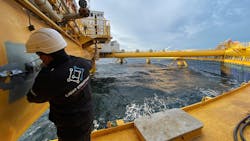Light Structures inks contracts for hull stress monitoring systems for FPSOs
By Ariana Hurtado, Editor and Director of Special Reports
HOUSTON — Light Structures AS is a supplier of fiber-optic condition monitoring systems based on Fiber Bragg Grating (FBG) technology. The company has been delivering structural monitoring systems for FPSOs for 20 years, so the team understands the nuances and special needs in the offshore oil and gas sector.
Earlier this month, the company was awarded two contracts with YANTAI CIMC Raffles Offshore for the delivery of extensive SENSFIB hull stress monitoring systems for two FPSO units.
The company's system monitors the stress responses in the hull structure during operations, which aims to help prevent design stresses being exceeded. SENSFIB Hull stress monitoring systems are based on the FBG sensors. The company says the FBGs are an internal stripe pattern in the core of the optical fiber that strongly reflects one wavelength (or color) of light, and the user interface can be configured to show current stress, fatigue accumulation, accelerations and slamming trends as well as sailing conditions in terms of sea state, wind, speed and position if such equipment is integrated.
For structural monitoring for FPSOs, Light Structures has taken orders for a total of seven so far this year and has a lot of installations already out there. The company plans to announce the most recent deals soon. According to the company, many oil and gas operators include FPSO structural monitoring within their operations.
"While FPSOs are stationary during operation, they are subject to many of the same forces as ships, which can increase the risk of accidents. Monitoring systems provide early warning of issues, helping to avoid the consequences of a structural failure," Sannerud said. "Further, it can extend the lifetime of an FPSO and reduce maintenance costs. Even though there are no regulations to mandate the use of the technology, many FPSO owners and operators are keen to have it on board."
The technology
Light Structures creates customized options for oil and gas companies based on the building blocks of its SENSFIB fiber-optic monitoring sensors.
"The monitoring scope for FPSO includes global structural monitoring, which measures forces running through the hull and low-cycle fatigue monitoring, which is the variation between ballast and loading," Sannerud said. "When the FPSO is loaded there is pressure on the tanks in one direction, but when the tanks are emptied, the pressure is in the opposite direction. The walls bend both ways, which can cause material fatigue over time. Maintenance regimes can be optimized to reduce costs and improve integrity by measuring this."
He explained that there are five levels to the company's technologies:
- Level 1 – Basic monitoring for real-time alerting on board;
- Level 2 – Added monitoring of local stresses at specific points;
- Level 3 – Monitoring for global forces, such as bending, stretching and torsion;
- Level 4 – Integrated Marine Monitoring Solution (IMMS), which matches a theoretical model with real data to provide predictive functionality; and
- Level 5 – IMMS integrated with digital twins for full 3D visualization and predictive capabilities.
There are two basic sensor types used for measuring the structural health of ships and boats: the electro-mechanical and fiber optic.
"Electro-mechanical structural health monitoring systems use long-base or LVDT sensors to measure stress on a hull or superstructure but have several drawbacks, including the need to weld sensors in place and the requirement to use a Zener Barrier circuit or galvanic separation to be explosion proof and intrinsically safe," Sannerud continued.
"Conversely, fiber-optic sensors, like those used in SENSFIB, can be installed quickly and easily using epoxy. They are also intrinsically and optically inherently safe without the addition of Zener Barriers and are unaffected by electro-magnetic interference."
The FBG technology in the sensors is designed to enable more accurate and granular raw data, as the stress measurements are based on the wavelength of light, he explained.
Digital twins
"While the advantages of fiber-optic sensors are clear, to our knowledge Light Structures is the only marine/offshore structural monitoring provider with the capability to link into digital twins, which are widely use in the sector to manage diverse operations in the E&P value chain," Sannerud said.
R&D is the company's largest department in terms of staff numbers, and the company has developed a software foundation that is designed to ensure that its customers have the flexibility to acquire, distribute and manage the data that SENSFIB unlocks, he explained.
"We believe that digital twins hold the key to improving safety and efficiency, which is why we have focused our R&D on ensuring that SENSFIB monitoring can be easily integrated regardless of the vendor or platform used," he added.
Floating wind applications
The company also has additional energy industry applications for the technology, including in the offshore renewable energy sector.
"Floating offshore wind is currently a key development market for Light Structures," Sannerud said. "Floating turbines are also subject to the same forces as ships, so monitoring stress and fatigue can provide data that will improve safety and maintenance regimes. Data from SENSFIB enables lower operating costs and less financial risk, which helps to prove the case for floating wind."
Looking ahead
Light Structures is working closely with class to ensure that structural monitoring data can provide value across many areas of marine operations as part of digital systems on ships, platforms and FPSOs.
"We are confident that digitalization is essential for improving safety at sea, reducing operational costs, and helping the offshore sector to reduce its operational carbon footprint," Sannerud concluded.
11.17.2023
About the Author
Ariana Hurtado
Editor-in-Chief
With more than a decade of copy editing, project management and journalism experience, Ariana Hurtado is a seasoned managing editor born and raised in the energy capital of the world—Houston, Texas. She currently serves as editor-in-chief of Offshore, overseeing the editorial team, its content and the brand's growth from a digital perspective.
Utilizing her editorial expertise, she manages digital media for the Offshore team. She also helps create and oversee new special industry reports and revolutionizes existing supplements, while also contributing content to Offshore's magazine, newsletters and website as a copy editor and writer.
Prior to her current role, she served as Offshore's editor and director of special reports from April 2022 to December 2024. Before joining Offshore, she served as senior managing editor of publications with Hart Energy. Prior to her nearly nine years with Hart, she worked on the copy desk as a news editor at the Houston Chronicle.
She graduated magna cum laude with a bachelor's degree in journalism from the University of Houston.


